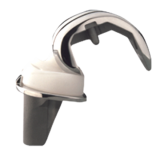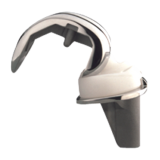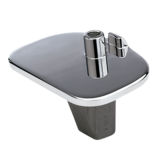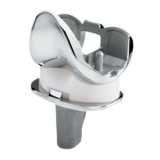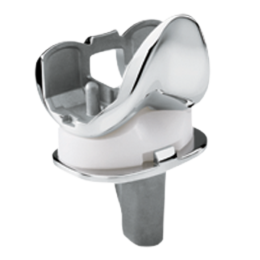Product Description
A Move Forward in Mobile Bearing Design
The Zimmer NexGen LPS-Flex Mobile and LPS-Mobile Bearing Knees provide an anteriorly positioned pivot near the entry point of the anterior cruciate ligament (ACL).
- An anterior pivot at the ACL site replicates the anatomic center of rotation1,2
- Anterior pivot design leads to lower patellofemoral forces that lead to anterior knee pain, patellar subluxation and dislocation, component wear, damage, and loosening3,4
- An anterior stop on the tibial plate prevents bearing spin-out and allows 25 degrees of unimpeded internal/external rotation
The LPS-Flex Mobile Bearing Knee Femoral Component has an enhanced cam/spine mechanism that is designed to provide stability at up to 155 degrees of active flexion.
- Deepened patellar groove delivers smooth patellar tracking, relieves pressure on the patella, and reduces forces that may cause patella clunk, pain, and premature wear
- Subluxation resistance increases at deep flexion angles as the cam moves down the spine
- Extended posterior flanges safely accommodate tibio-femoral contact during deep flexion
Wear
- Increased contact area/lower contact stresses
- Frontal plane conformity ratio
| LPS-Flex Mobile Bearing Knee | 1:1 |
| DePuy P.F.C* Sigma Rotating Platform | 1.03:1 |
- Sagittal plane conformity ratio at extension and low angles of flexion5
| Zimmer NexGen LPS-Flex Mobile Bearing Knee | 1.005:1 |
| DePuy P.F.C* Sigma Rotating Platform | 1.02:1 |
- Femoral radii are matched to size-specific articular surfaces
- Allowing only unidirectional rotational motion potentially reduces cross-shear and consequent wear6
Refer to the package insert for indications, contraindications, warnings, precautions and adverse effects.
*P.F.C® is a trademark of Johnson & Johnson Corporation
Successful Clinical History
The LPS-Flex Mobile Bearing Knee is supported by both clinical history and published study results.
- Ten years of successful clinical history in the European Union and Japan
- A study published in The Journal of Arthroplasty in 2010 reports a higher degree of postoperative flexion with the LPS-Flex Mobile Bearing Knee than with comparable mobile bearing designs reported in the literature7
- A study published in Clinical Orthopaedics and Related Research in 2004 reports patients with LPS-Flex Mobile Bearing Knee had similar kinematics patterns to the control patients with a healthy knee8
- A study published in the Journal of Biomechanics in 2005 reports implanted patella experienced similar kinematics to the non-implanted healthy knee9
Product Brochure
References
- Argenson JN, Scuderi GR, Komistek RD, Scott WN, Kelly MA, Aubaniac JM. In vivo kinematic evaluation and design considerations related to high flexion in total knee arthroplasty. J Biomech. 2005;38(2):277-284.
- Hollister AM, Jatana S, Singh AK, Sullivan WW, Lupichuk AG. The axes of rotation of the knee. Clin Orthop Relat Res. 1993;290:259-268.
- Smith AJ, Lloyd DG, Wood DJ. Pre-surgery knee joint loading patterns during walking predict the presence and severity of anterior knee pain after total knee arthroplasty. J Orthop Res. 2004;22(2):260-266.
- Browne C, Hermida JC, Bergula A, Colwell CW Jr, D’Lima DD. Patellofemoral forces after total knee arthroplasty: effect of extensor moment arm. Knee. 2005;12(2):81-88.
- Gsell R, Yao JQ, Laurent MP, Crowninshield RD: Improved oxidation resistance of highly crosslinked UHMWPE for total knee arthroplasty. Society for Biomaterials 28th Annual Meeting Transactions, 542, 2002.
- ZRR_WA_1577_06
- Jones, V.C. et al. An experimental model of tibial counterface polyethylene wear in mobile bearing knees: The influence of design and kinematics. Bio-medical Materials & Related Research, 1999;9:189-196.
- Tarabichi, S. et al. Achieving Deep Flexion After Primary Total Knee Arthroplasty. Journal of Arthroplasty. 2010; Vol.25,No.2,219-224.
- Scuderi G.R. et al. In vivo kinematic evaluation and design considerations related to high flexion in total knee arthroplasty. Journal of Biomechanics. Number 38, pp 277-284. 2005.
- Ranawat, C.S. “Design features of mobile-bearing knee implants”, Orthopedics Today, Technical Monograph to the Dec. 2000 issue, 10-122, 2000
Indications: The NexGen® LPS-Flex/LPS-Mobile Bearing Knees are posterior-stabilized, cemented, knee prostheses indicated for patients with severe knee pain and disability due to osteoarthritis, traumatic arthritis, femoral avascular necrosis and moderate valgus, varus, or flexion deformities.
Contraindications: The device is contraindicated in patients with affected joint or systemic infection, insufficient bone stock, osteoporosis, skeletal immaturity or severe instability of the joint.
Warnings: Do not reuse (single patient use only). All 17 and 20mm articular surfaces require a locking screw. Use only NexGen all-polyethylene patellas with these mobile knees. Do not use; any damaged component, components from other knee systems, CR, CRA, CR-Flex or any porous components.
Precautions: Use sizing charts to correctly match components. Safety and effectiveness of this device has not been established in patients with rheumatoid arthritis, collagen disorders, polyarthritis, or pseudogout; or in patients who need a revision total knee replacement.
Adverse Effects: Implant loosening due to osteolysis, tibiofemoral subluxation or bearing disassembly, dislocation, joint instability or knee stiffness.
Refer to the package insert for indications, contraindications, warnings, precautions and adverse effects.
Contraindications: The device is contraindicated in patients with affected joint or systemic infection, insufficient bone stock, osteoporosis, skeletal immaturity or severe instability of the joint.
Warnings: Do not reuse (single patient use only). All 17 and 20mm articular surfaces require a locking screw. Use only NexGen all-polyethylene patellas with these mobile knees. Do not use; any damaged component, components from other knee systems, CR, CRA, CR-Flex or any porous components.
Precautions: Use sizing charts to correctly match components. Safety and effectiveness of this device has not been established in patients with rheumatoid arthritis, collagen disorders, polyarthritis, or pseudogout; or in patients who need a revision total knee replacement.
Adverse Effects: Implant loosening due to osteolysis, tibiofemoral subluxation or bearing disassembly, dislocation, joint instability or knee stiffness.
Refer to the package insert for indications, contraindications, warnings, precautions and adverse effects.


